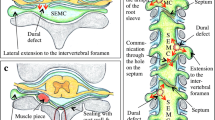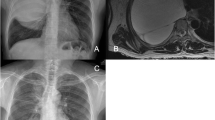Abstract
Neurofibromatosis type 1 (NF1) is a multisystem neurocutaneous disorder. Scoliosis and dural ectasia are features of the associated mesodermal dysplasia. Lateral thoracic meningoceles can develop in NF1 and progressively enlarge due to cerebrospinal fluid (CSF) pulsations. Large meningoceles can cause compressive symptoms in the thorax. We are reporting a case of a NF1 presenting with acute onset respiratory distress, who also had chronic orthostatic headaches. CT chest showed unruptured enlarging bilateral lateral thoracic meningoceles causing lung compression. MRI of the brain and spine showed features of CSF hypotension, explaining the headaches. CSF hypotension with unruptured meningoceles is extremely rare. Management of the condition is challenging since surgical removal is prone to complications due to underlying mesodermal abnormalities. Cystoperitoneal shunting to relieve lung compression may worsen CSF hypotension. A shunt with a programmable valve allowed controlled drainage and successfully relieved lung compression without worsening of orthostatic headaches in our case.


Similar content being viewed by others
References
Williams VC, Lucas J, Babcock MA, Gutmann DH, Korf B, Maria BL (2009) Neurofibromatosis type 1 revisited. Pediatrics 123(1):124–133
Khoo Bao JN, Ogunwale B, Huson SM, Ealing J, Whitehouse RW (2013) Spinal bone defects in neurofibromatosis type I with dural ectasia: stress fractures or dysplastic? A case series. Eur Radiol 23(12):3418–3421
Jeong JW, Park KY, Yoon SM, Choe du W, Kim CH, Lee JC (2010) A large intrathoracic meningocele in a patient with neurofibromatosis-1. Korean J Intern Med 25(2):221–223
VandeVrede L, Colorado RA, Lee JW (2016) Dizziness caused by meningocele-associated intracranial hypotension in neurofibromatosis type 1. Neurology 87(15):1627–1628
Kim KW, Cho JH (2021) Iatrogenic giant pseudomeningocele of the cervical spine: a case report. World J Clin Cases. 9(31):9686–9690
Kihara T, Mitsueda T, Ito K, Miyata M (2004) Intracranial hypotension caused by traumatic intrasacral meningocele. J Neurol Neurosurg Psychiatry 75(4):658
Lin JP, Zhang SD, He FF, Liu MJ, Ma XX (2017) The status of diagnosis and treatment to intracranial hypotension, including SIH. J Headache Pain 18(1):4
Kranz PG, Gray L, Malinzak MD, Houk JL, Kim DK, Amrhein TJ (2021) CSF-venous fistulas: anatomy and diagnostic imaging. AJR Am J Roentgenol 217(6):1418–1429
Maiuri F, Corriero G, Giampaglia F, Simonetti L (1986) Lateral thoracic meningocele. Surg Neurol 26:409–412
Tanaka K, Shimizu K, Kakegawa S, Oshima K, Takeyoshi I (2011) Cystoperitoneal shunt for a giant intrathoracic meningocele under local anesthesia. Ann Thorac Surg 91:317–319
Acknowledgements
We are grateful to Dr. Rudy Van Hemert, division chief of Neuroradiology, University of Arkansas for Medical Sciences, for his constant support, guidance and encouragement.
Disclosures
The authors have no relevant financial or non-financial interests to disclose.
Funding
No funds, grants, or other support was received.
Author information
Authors and Affiliations
Corresponding author
Ethics declarations
Conflict of interest disclosure
We declare that we have no conflict of interest.
Ethics approval
Waived by the Institutional Ethics Committee as the study involved retrospective reporting of a case and did not involve any interventions on human or animal subjects.
Informed consent
Informed consent was obtained from the participant included in the study. The participant has consented to the submission of the case report to the journal, provided all identifying data have been removed. Accordingly, all identifying data has been removed from the images.
Additional information
Publisher’s note
Springer Nature remains neutral with regard to jurisdictional claims in published maps and institutional affiliations.
Rights and permissions
Springer Nature or its licensor (e.g. a society or other partner) holds exclusive rights to this article under a publishing agreement with the author(s) or other rightsholder(s); author self-archiving of the accepted manuscript version of this article is solely governed by the terms of such publishing agreement and applicable law.
About this article
Cite this article
Krishnan, V., Rana, A. & Vattoth, S. Unruptured giant lateral thoracic meningocele: extremely rare cause of cerebrospinal fluid (CSF) hypotension in neurofibromatosis type 1. Neuroradiology 66, 1235–1238 (2024). https://doi.org/10.1007/s00234-024-03381-4
Received:
Accepted:
Published:
Issue Date:
DOI: https://doi.org/10.1007/s00234-024-03381-4




